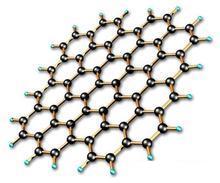 NASA has developed atom-sized miniature sensors based on graphene to detect trace elements in the Earth’s upper atmosphere and structural defects on the spacecraft.
NASA has developed atom-sized miniature sensors based on graphene to detect trace elements in the Earth’s upper atmosphere and structural defects on the spacecraft. Sultana, a technical expert at the NASA Goddard Space Flight Center, said that his research team began researching and developing nanometer-sized detectors based on graphene two years ago to detect atomic oxygen and other trace elements above the atmosphere from aircrafts. All structural pressure from the wing to the spacecraft bus. Jeff Stewart, the chief assistant of the Center's Mechanical Systems Division, said: "The coolest thing about graphene is its own properties, which provide a lot of possibilities for research. Frankly, we have only just begun."
More than a year ago, Sultana's team began developing graphene equipment based on chemical vapor deposition (CVD) technology. They place a metal substrate in a vacuum chamber and inject gas to create the desired film. The team has now succeeded in producing high-quality graphene sheets. Sultana said: "One of the most promising applications for this material is as a chemical sensor."
Now, the research team has developed a small, low-quality, low-power graphene sensor that can measure the atomic weight of oxygen in the atmosphere. The amount of oxygen atoms in the air above the atmosphere is created when the ultraviolet radiation of the sun breaks down oxygen molecules, and the related elements generated by it are highly corrosive. When satellites fly over the atmosphere, they are attacked by this chemical at a speed of about 5 miles per second (about 8 kilometers), which seriously damages the spacecraft's common materials, such as polyimide films.
Although scientists believe that oxygen atoms make up 96% of the lean atmosphere in low Earth orbit, they have found that they may cause the orbital spacecraft to lose its altitude drop prematurely when measuring its density and more accurately determining its role in atmospheric resistance. To the earth. The researchers said: "We still don't know the effect of drag forces created by oxygen atoms on the spacecraft; we don't know how much momentum is transferred between atoms and spacecraft, and this is very important because engineers can use this effect. To assess the longevity of the spacecraft and how long it will take for the spacecraft to return to Earth's atmosphere.â€
Sultana said that graphene sensors provide a good solution for this. When graphene absorbs oxygen atoms, the resistance of the material changes, and the graphene sensor can quickly measure a more accurate density. "This is really exciting. We hope to be able to calculate the change in frequency resistance and greatly simplify the procedure for measuring oxygen atoms."
Sultana said that this chemical sensor can not only measure oxygen atoms, but also measure methane, carbon monoxide and other planetary gases, as well as gaseous substances released from the planet.
OUBAO deals in Pull Out Kitchen Faucet and Hot Cold Kitchen Faucet. We use high quality and environmentally friendly zinc alloy materials, in line with international standards, the surface plating chromium technology will never rust. OUBAO faucet is designed for copper in and out of water. OUBAO has realized the structure of zinc and copper die-casting.
Kitchen Faucets,Kitchen Tap,Modern Faucet,Kitchen Faucet Parts
Kaiping Oubao Sanitary Ware Hardware Co., Ltd. , http://www.oubaofaucet.com